Submarine forces (France)
The Submarine Forces of France (French: Forces Sous-Marines, FSM) is one of the four main components of the French Navy. This Submarine Force regroups the ensemble of French submarines capability types.
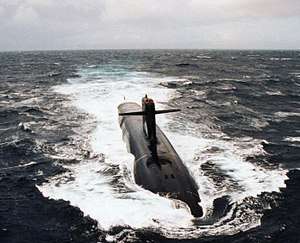
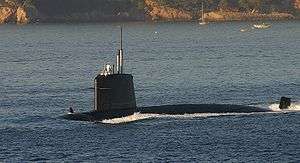
French submarine headquarter staff is a self-sufficient command made up of two prime components:[1][2]
- The Strategic Oceanic Force (French: Force Océanique Stratégique, FOST), formed of several French nuclear ballistic missile submarines with base in French arsenals. ALFOST commandment commenced in 1972.
- The Squadron of Nuclear Attack Submarines (French: Escadrille des Sous-Marins Nucléaires d'Attaque, ESNA), formed in a squadron of several French nuclear attack submarines with base in French arsenals.
French submarine forces are armed with over 4000 military and civilian personnel out of which an estimated 2000 Submariners (French: Sous-Mariniers).
The French général Naval Officer (French: L'Officier général de marine), the Amiral (Admiral) Commandant of the Strategic Oceanic Force (French: Commandant la Force Océanique Stratégique, ALFOST), ensures the commandment of submarine forces, under the authority of the Chief of Staff of the French Navy (French: Chef d'Etat-Major de La Marine).
History of French submarine forces
Origin
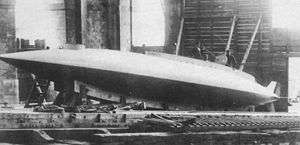
The first submarine which avoided human propulsion was Plongeur of the French Imperial Navy (French: Marine Impériale Française), launched in 1863, and equipped with a compressed-air motor of 23 reservoirs of pressure at 180 PSI.
In 1888, Gymnote was the first submarine to be equipped with specific metal batteries. Gymnote would be followed by Morse in 1899, then the Farfadet series in 1901. Their range was recorded at 100 miles.
In June 1900, French submarine Narval, introduced a double hull, with an internal composition inside the pressure hull. During this époque, France was without a doubt the first navy to have a formidable submarine force. These 200 ton submarines had a range exceeding 100 miles on the surface and 10 miles underwater. The French submarine Aigrette of 1904 further improved the concept by running a diesel motor instead of a motor with fuel while surfaced. 76 submarines were completed by 1914.
First World War
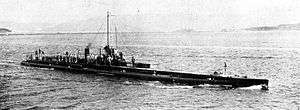
At the launching of World War I in August 1914, the French Navy aligned 72 submarines essentially to mount the defensive of coastlines, out of which 50 units were at sea, placed in order of 90 during that conflict and almost 70 at sea by 1918.
Fifty-nine of these boats conducted more than 1300 sea war sorties and fourteen of those were lost in the conflict out of which twelve in the Mediterranean, among the boats were, Curie which was scuttled during a tentative attack on the base of Pula in December 1914, and would be refitted by the Austro-Hungarian Navy, and one would be captured by the Ottoman Navy. The Foucault, drowned in a bombardment by hydroplanes of the Austro-Hungarian Navy at the large of Kotor on September 15, 1915, and was the first submarine to be the victim of an aerial attack.
Surpassed by the technological plans of the correspondent great powers, their role in the Submarine warfare was minor. At the title of war damages, France received 46 U-Boats from the Imperial German Navy, most were steeled between 1922 and 1923, following the signature of the Washington Naval Treaty, as well as various materials including a dock tube to test submarines while simulating pressure reached while in immersion. This dock tube installed in France allowed a reaching pressure of 7 kg/cm2, as in an immersion of 70 meters. This tube was able to welcome submarines with maximal length of 80 meters and a maximal hull diameter of 9 meters.
Interwar period
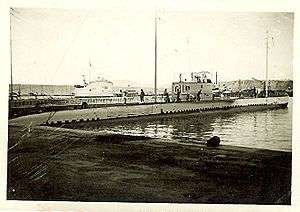
In 1922, French submarine forces counted 48 boats, all constructed after 1911. On January 1, 1930, France had the most powerful Submarine Fleet in the world with 110 units forming the tonnage constituent of 97,875 tons in service, construction or in authorized commission.
However the French naval construction witnessed set-backs in perfecting the submarines production (certain set-backs were witnessed as the level of maintenance for instance) and were classified as various initiatives, categorizing the submarines on a general scale while sharing the same characteristics (same dimensions, displacement, armament and other features). In any case, the French differentiated their submarines by their displacement: 1500 tons, 1100 tons, 600 tons and so forth. Accordingly, several classes of submarines were formed for the years 1921-1931, out of which the most prominent were:
- Requin-class, first class submarine (grand patroller).
- 1500 tons-class, first class submarine (grand patroller).
- 600-630 tons-class, consisting of several series.
- Minerve-class.
- Surcouf, grand cruiser.
- Various other submarine classes.
Second World War
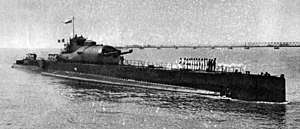
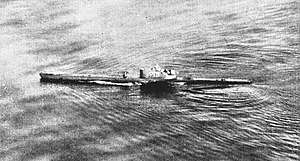
At the declaration of World War II in September 1939, French submarine forces aligned 77 vessels out of which 47 were launched in advantage ten years prior and 19 submarines in due course of construction, a submarine supply vessel, the Jules Verne was in service since April 1932. The French Navy counted 9 units of 1200 tons-class, 29 units of the 1500 tons-class (Le Prométhée and Le Phénix, were lost accidentally in 1932 and 1939); 38 units of the 600 tons-class (L'Ondine was lost in 1928 and La Nymphe was condemned in 1938) out of which 6 mine laying submarines of the Saphir-class and grand cruiser Surcouf, which displaced 3300 tons in surface, being the largest submarine in the world during the époque. Besides grand cruiser Sucouf, the German U-boat of the Kriegsmarine were technically superior as an entire.
During the Armistice of 22 June 1940, 602 type 550mm and 187 type 400mm torpedoes along with 332 Naval mines types were available in a French port and elsewhere in French possessions.
Following the defeat during the Battle of France, only three submarines joined the Free French Naval Forces in 1940, Le Rubis, Le Narval (drowned by a naval mine on December 21, 1940), and Surcouf (accidentally drowned or by misunderstanding during the night of the 18 and 19 of February 1942).
One submarine drowned during the Norwegian Campaign and several French submarines under command of the Army of Vichy (French: armée de Vichy) were drowned or damaged by the Allies during the various combats taking place in the French colonial empire (French: divers combats ayant lieu dans l'empire colonial français).
The Battle of Dakar (French: bataille de Dakar) in September 1940 witnessed the loss of two submarines of the French State (French: État Français) while Le Bévéziers severely aggravated a battleship. Three others, out of which Le Béveziers, were lost in May 1942 during the Battle of Madagascar (French: bataille de Madagascar).
During the Scuttling of the French fleet in Toulon (French: sabordage de la flotte française à Toulon), five submarines, out of which Casabianca commanded by Jean L'Herminier, managed to exit the raid on Toulon despite the magnetic mines and on going bombardment.
The attack summary of French submarine torpedoes during the Second World War could be resumed within the following:
- 1939 : no attacks.
- January to May 1940 : 4 attacks, 9 torpedoes launched all missed.
- June 1940 - 1942 :
- Free French Naval Forces (FNFL): 8 attacks, 13 torpedoes launched, 6 missed targets, 2 sunk.
- Vichy : 14 attacks - 37 torpedoes launched, 1 target sunk, 1 target damaged.
- 1943 : 11 attacks, 33 torpedoes launched, 3 targets sunk, 1 target damaged.
- 1944 : 16 attacks, 36 torpedoes launched, 2 targets sunk.
The submarines participated to numerous unconventional operations by dropping agents, forces of the resistant and materials in occupied Europe and the Le Casabianca played an important role in the Liberation of Corsica (French: Libération de la Corse) while transforming in a troop transport service.
On January 1, 1945, France has en parc eight submarines dits first class, twenty submarines of second class out of which four were lent by the United Kingdom, one mine laying submarine and supply ship for submarines.
On May 8, 1945, nineteen vessels (French: bâtiments) are in activity out of which nine were operational (three lent by the United Kingdom) with the personnel, on January 1, 1946 were reduced to 700 men.
During the Occupation of France by Germany (French: Occupation de la France par l'Allemagne), the Kriegsmarine built, for its own submarines, several installations along the façade of the French Atlantic.
After-war époque
Following the Capitulation Acts of the Third Reich (French: capitulation du Troisième Reich), France received a total of 85 vessels, former German made, out of which six combat submarines (Roland Morillot in service until 1967) and four pocket submarines ( in service until 1954) as well as an Italian coastal submarine. Only four out of them were placed in permanent active duty service with the French Navy assimilating the advanced techniques and tactics of World War II.
The reconstruction phase debuted with launched research at the end of the conflict, five submarines of the Aurore-class (also often designated Créole-class) which the construction was interrupted in 1940 were commissioned afloat until retrieval, the eldest retrieved in 1967.
Conventional attack submarine
During the years 1970/1980, the diesels were spread in the Submarines Squadron of the Atlantic (ESMAT) and the Submarines Squadron of the Mediterranean (ESMED). In 1995, the remaining ESMA was dissolved with last submarine leaving port on February 11, 1997. The four Agosta and the two last Daphné are regrouped at the corps Submarines Atlantic Group (GESMAT), created in 1995. The latter was to the turn dissolved on July 1, 1999 and the two ultimate Agosta, La Praya and L'Ouessant, integrated the FOSt until their retrieval.
Since the years of 1970, the French submarine fleet consisted of:
- Four Aréthuse-class placed into service between 1958 and 1960.
- Six Narval-class placed into service between 1957 and 1960.
- Nine Daphné-class placed into service between 1964 and 1969.
- Various other submarine classes.
On November 1, 1970, the 1st squadron, counting 11 units, were designated as Submarines Squadron of the Mediterranean (ESMM, then ESMED) and the 2nd squadron created in 1947 which was formed of eight vessels, six of type Narval and two of type Daphne, became the Submarine Squadron of the Atlantic (ESMA, then ESMAT).
- Four Agosta-class of French conception of the years 1970 and placed into service in 1977 and 1978 with retrieval in 2001.
| |||||||||||||||||||||||||||||
Nuclear era
On January 28, 1972, the first Ballistic missile submarine of the Le Redoutable-class left a submarine base for the first patrol of nuclear deterrence. With the creation of FOST, the ensemble of the submarine force was subordinated to its support in the associated respective role of Nuclear deterrence.
French nuclear attack submarines
With the service commencement of French nuclear ballistic missile submarines in the French Navy in the years of 1970, it was decided to construct a class of French nuclear attack submarines Rubis. Adopting several designations first, the nuclear propulsion was later designated as Provence-class ( with the next two vessels being designated as Bretagne and Bourgogne), before being baptized under the Presidency of Valéry Giscard d'Estaing. These were one of the most compact nuclear attack submarines in the world along with reactor integration. Built since 1976, the first was delivered in 1983. Six were finally in service, the last in 1993. Their nuclear propulsion and speed allows the submarines to arrive in any zone with total discretion along the Oriental Mediterranean, Occidental Africa, the Antilles, the Persian Gulf, the Pacific Ocean, and other Oceans and Seas.
Occupied essentially, but not exclusively by operations of Anti-submarine warfare at the profit of deterrence, since the creation of the Strategic Oceanic Force, the employment scope range of the attack submarines was enlarged since the middle of the years of 1990 with the leveling placement of nuclear attack submarines which can act at the profit of Carrier battle groups and maritime action.
The six French nuclear attack submarines of the Rubis entered into service in the French Navy between 1983 and 1993. The Rubis were the main class of nuclear attack submarines actually in service since the retrieval of the last classic propulsion submarines in 2001. The Squadron of Nuclear Attack Submarines (ESNA) depends of the force océanique stratégique which assimilated the Submarine Forces at the end of the 20th century.
French nuclear attack submarines
- Rubis class
- Rubis (S601) ( 1983 - )
- Saphir (S602) (1984 - 2019 )
- Casabianca (S603)( 1987 - )
- Émeraude (S604) ( 1988 - )
- Améthyste (S605) ( 1992 - )
- Perle (S606) ( 1993 - 2020 (Fire during renovations))
- Suffren class
French nuclear ballistic missile submarines
Six French nuclear ballistic missile submarines of the Le Redoutable class capable of carrying sixteen ballistic missiles were built:
- Le Redoutable (1971-1991)
- Le Terrible (1973-1996)
- Le Foudroyant (1974-1998)
- L'Indomptable (1976-2003)[3]
- Le Tonnant (1980-1999)
- L'Inflexible (1985-2008)
Four French nuclear ballistic missile submarines of a newer generation, the Le Triomphant class, are in service in 2010 in the force océanique stratégique of the French Navy:
- Le Triomphant (S616) (entered in service since 1997)
- Le Téméraire (S617) (entered into service since 1999)
- Le Vigilant (S618) (entered into service since 2004)
- Le Terrible (S619) (entered into service since 2010). Le Terrible was presented on March 21, 2008, and entered service at the end of September 2010 to replace the L'Inflexible, last of the retrieved Le Redoutable class ballistic missile submarine in 2008.
The armament systems of the ballistic missile submarines include in general:
- 16 missiles M45 with TN 75 heads (nuclear deterrence). French Nuclear deterrence also includes M51 missiles.
- 4 tubes of 533mm for F17 torpedoes and Exocet SM39 anti-ship missiles.
The mission of a French Nuclear Ballistic Missile Submarine is simple: leave the designated port of attachment, in the most discreet possible way, remain undetectable all along the mission to be able at any moment launch a nuclear strike, under orders of the President of France.
See also
- Chef d'État-Major des Armées
- Major (France)
- French Navy
- French Naval Aviation
- List of Escorteurs of the French Navy
- List of submarines of France
- French Air Force
References
Bibliographies
- L'Encyclopédie des Sous-Marins Français, 1er Tome, Thierry d'Arbonneau. Éditions SPE Barthélémy, 2009 ISBN 2-912-83843-6
- L'Odyssée Technique et Humaine du Sous-Marin en France - Tome I : Du Plongeur (1863) aux Guêpe (1904), Gérard Garier, Marines Éditions
- L'Odyssée Technique et Humaine du Sous-Marin en France - Tome II : Des Emeraude (1905-1906) au Charles Brun (1908-1933), Gérard Garier, Marines Éditions
- L'Odyssée Technique et Humaine du Sous-Marin en France - Tome III : Des Clorinde (1912-1916) aux Diane (1912-1917), Gérard Garier, Marines Éditions
- L'Odyssée Technique et Humaine du Sous-Marin en France - Tome IV : Des Joessel au Jean Corre, Ex-UB 155, Gérard Garier, Marines Éditions
